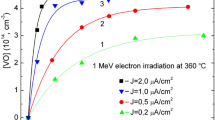Abstract
Recently we reported room temperature point defect creation and subsequent extended defect nucleation in nitrogen-doped silicon during 200 kV electron irradiation, while identical irradiation of nitrogen-free silicon produced no effect. In this paper, first principles calculations are combined with new transmission electron microscope (TEM) observations to support a new model for elastic electron-silicon interactions in the TEM, which encompasses both nitrogen doped and nitrogen free silicon. Specifically, the nudged elastic band method was used to study the energetics along the diffusion path during an electron collision event in the vicinity of a nitrogen pair. It was found that the 0 K estimate for the energy barrier of a knock-on event is lowered from ∼ 12 to 6.2 eV. However, this is still inadequate to explain the observations. We therefore propose an increase in the energy barrier for Frenkel pair recombination associated with N2-V bonding. Concerning pure silicon, stacking fault formation near irradiation-induced holes demonstrates the participation of bulk processes. In low oxygen float zone material, 2–5 nm voids were formed, while oxygen precipitation in Czochralski Si has been verified by electron energy-loss spectroscopy. Models of irradiation-induced point defect aggregation are presented and it is concluded that these must be bulk and not surface mediated phenomena.
Similar content being viewed by others
References
G. A. ROZGONYI, in “Semiconductor Silicon 2002,” in Proceedings of the Electrochemical Society 2002–1 (The Electrochemical Society, New Jersey, 2002) p. 149.
M. TAMATSUKA, N. KOBAYASHI, S. TOBE and T. MATSUI, in Proceedings of the Electrochemical Society 99–1 (The Electrochemical Society, New Jersey, 1999) p. 456.
K. NAKAI, Y. INOUE, H. YOKOTA, A. IKARI, J. TAKAHASHI, A. TACHIKAWA, K. KITAHARA, Y. OHTA and W. OHASHI, J. Appl. Phys. 89 (2001) 4301.
A. KAROUI, F. S. KAROUI, G. A. ROZGONYI, M. HOURAI and K. SUEOKA, J. Electrochem. Soc. 150(2003) G771.
H. KAGESHIMA, A. TAGUCHI and K. WADA, Appl. Phys. Lett. 76(2000) 3718.
N. STODDARD, A. KAROUI, G. DUSCHER, A. KVIT and G. ROZGONYI, Electrochem. Sol. State Lett. 6 (2003) G134.
S. J. PENNYCOOK and L. A. BOATNER, Nature 366 (1988) 565.
P. E. BLOCHL, E. SMARGIASSI, R. CAR, D. B. LAKS, W. ANDREONI and S. T. PANTELIDES, Phys. Rev. Lett. 70 (1993) 2435.
G. D. WATKINS, Mat. Sci. Semicond. Proc. 3 (2000) 227.
R. S. AVERBACK and T. DIAZ DE LA RUBIA, Sol. State Phys. 51 (1997) 281.
W. WINDL, T. J. LENOSKY, J. D. KRESS and A. F. VOTER, Nucl. Inst. Meth. Phys. B 141 (1998) 61.
J. YAMASAKI, S. TAKEDA and K. TSUDA, Phys. Rev. B 65 (2002) 115213.
D. N. SEIDMAN, R. S. AVERBACK, P. R. OKAMOTO and A. C. BAILY, Phys. Rev. Lett. 58 (1987) 900.
L. REIMER, in “Transmission Electron Microscopy: The Physics of Image Formation and Microanalysis” (Springer-Verlag, Berlin, 1993) p. 210.
R. F. EGERTON, in “Electron Energy-Loss Spectroscopy in the Electron Microscope,” 2nd ed. (Plenum Press, New York, 1996) pp. 137, 186.
N. STODDARD, G. DUSCHER, A. KAROUI, F. STEVIE and G. ROZGONYI, “Segregation and Enhanced Diffusion of Nitrogen in Silicon Induced by Low Energy Ion Bombardment,” Submitted to J. Appl. Phys, 2004.
H. SAWADA, K. KAWAKAMI, A. IKARI and W. OHASHI, Phys. Rev. B 65 (2002) 075201.
V. S. VAVILOV, A. E. KIV and O. R. NIYAZOVA, Phys. Stat. Sol. (a)32 (1975) 11.
This area is 1/4 the area of one side of the Si unit cell, about the interaction area of a beam electron
This is the probability for interaction in 1 nm thickness, 0.00001, divided by the 4 atoms in 1/4 of the unit cell area over two unit cells’ thickness
Author information
Authors and Affiliations
Corresponding author
Rights and permissions
About this article
Cite this article
Stoddard, N., Duscher, G., Windl, W. et al. A new understanding of near-threshold damage for 200 keV irradiation in silicon. J Mater Sci 40, 3639–3650 (2005). https://doi.org/10.1007/s10853-005-1059-z
Received:
Accepted:
Issue Date:
DOI: https://doi.org/10.1007/s10853-005-1059-z




